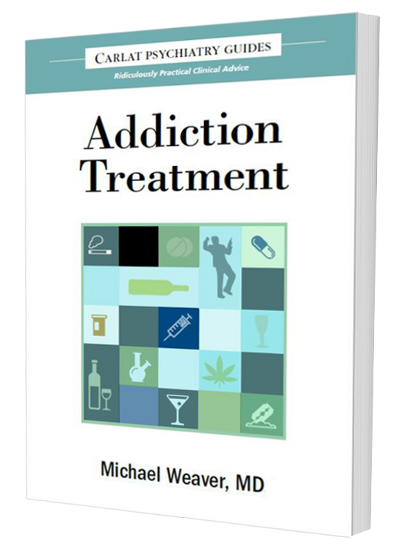The insert is a 5 X 8 inch 4 page booklet. The front cover is below:
Evidently appealing to the scratch-ticket set among psychiatrists, Vanda drew cartoons of three different brain receptors: 5-HT2A (serotonin 2A), D2 (dopamine 2), and D3 (dopamine 3). The quiz question is: "The blocking of which of these receptors distinguishes atypical antipsychotics from conventional agents?"
Most psychiatrists presumably know that all atypical antipsychotics are mixed D2/5HT2A antagonists, whereas conventional antipsychotics block D2 but not 5-HT2A. Nobody outside of biochemistry labs knows what "D3" does, so that's certainly not the answer. As you can see, I vigorously scratched off 5-HT2A, which is the right answer. I scratched off the other two just to see what was underneath (honestly, I scratched those after 5-HT2A!)
Anyway, after uncovering the green and blue arrows, I was instructed to "continue on to learn about the receptor binding of one specific atypical antipsychotic agent." So I turned the page:
Most psychiatrists presumably know that all atypical antipsychotics are mixed D2/5HT2A antagonists, whereas conventional antipsychotics block D2 but not 5-HT2A. Nobody outside of biochemistry labs knows what "D3" does, so that's certainly not the answer. As you can see, I vigorously scratched off 5-HT2A, which is the right answer. I scratched off the other two just to see what was underneath (honestly, I scratched those after 5-HT2A!)
Anyway, after uncovering the green and blue arrows, I was instructed to "continue on to learn about the receptor binding of one specific atypical antipsychotic agent." So I turned the page:
Here you read what is (to the uninitiated) a bunch gobbledygook about binding affinities, cholinergic receptors, etc.... For the well trained psychiatrists, however, this is, well, a bunch of gobbledygook about binding affinities and receptors. Vanda is boasting about Fanapt's "distinct" receptor profile, but in the fine print, they admit that "The clinical significance of the receptor-binding affinity of FANAPT is unknown."
You can say that again. In fact, Fanapt touts its low affinity for H1 (histamine) receptors, implying that it won't cause sedation and weight gain. Unfortunately, in the real (clinical) world, "somnolence" is one of Fanapt's prominent side effects (package insert), and it caused significantly more weight gain than Geodon in head to head trials--6.2 pounds vs. Geodon's 2.4 pounds after 4 weeks of treatment (see abstract here).
Vanda doesn't highlight the fact that Fanapt causes a potentially dangerous EKG change called QT widening, and that one of its receptor binding properties causes so much dizziness upon standing up that patients have to increase the dose very gradually to prevent fainting. Yes, you can find this information in the insert, but you'll have to look for it.
This is deceptive advertising, because the underlying message is "Fanapt is better than other antipsychotics because it's biochemically special," but the reality is that the biochemistry of Fanapt is not clearly related to its side effects, it is no more effective than any other antipsychotic, and it costs over $600/month.
My beef isn't just with Vanda's sleezy ad, but also with the APA, which made the wrong decision to grab the large amount of money that such special inserts cost. It is the responsibility of the editors to screen such ads and to reject them when they are misleading.




 Subscribe to our RSS Feed!
Subscribe to our RSS Feed!

5 comments:
"The clinical significance of the receptor-binding affinity of FANAPT is unknown."
The same statement appears in the literature for virtually every other medication we prescribe.
I do prescribe drugs like Fanapt, and sometimes see miraculous responses. But there's something strangely unsettling about practicing a branch of medicine in which we routinely ask our patients to put their faith in an unsubstantiated theory of illness and pay hundreds of dollars to put a chemical in their bodies whose effects we don't really know.
How did we get here again?
Surprise, surprise, the APA is yet again involved in a controversy that raises the question of ethical and unscrupulous behaviors by an organization that allegedly represents psychiatry as a whole.
What is the current percentage of actively practicing psychiatrists who are members of the APA as of 2011?
What is your point? This data is directly from the package insert and this is informative to me as a psychiatrist.
SteveBMD...
I take drugs like Fenapt. On their own they aren't miraculous, but with an old one, they work wonders. There is something strangely unsettling about taking a bunch of meds because my psychiatrist tells me they will help me, but she has no clue why they help. They just do. I've read the inserts-the "unsubstantiated theory of illness"-when somewhere else in the insert it says that the mechanism of action is unknown. I have been taking psych meds for the better part of my life. Currently, I take 5 meds and they keep me pretty stable. I don't pay hundreds of dollars a month to put chemicals into my body whose effects no one knows...I pay thousands.
How did I get here again? Oh yeah, I have schizophrenia.
That flyer tumbled out of my mail today!
Post a Comment